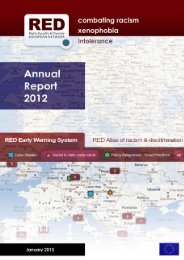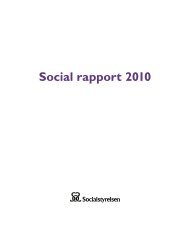Entry Testing and the Overrepresentation of Romani ... - UR Research
Entry Testing and the Overrepresentation of Romani ... - UR Research
Entry Testing and the Overrepresentation of Romani ... - UR Research
- No tags were found...
You also want an ePaper? Increase the reach of your titles
YUMPU automatically turns print PDFs into web optimized ePapers that Google loves.
R28PITFALLS AND BIASBias in test administrationWhen using translated versions <strong>of</strong> assessments <strong>and</strong> interpreters to administer assessments to children whoseprimary language is not <strong>the</strong> dominant language, <strong>the</strong>re are still issues to consider in diagnosis <strong>and</strong> placement.Direct translations <strong>of</strong> assessments might be inappropriate to use with individuals who speak different dialects(Olmedo 1981, 1,083). In a review <strong>of</strong> school psychologists’ reports for English Language Learners in California,Figuero <strong>and</strong> Newsome (2006) determined that only one test was used to collect data (ra<strong>the</strong>r than using varioustests across multiple domains as is best practice), tests were not administered in <strong>the</strong> child’s home language,<strong>the</strong> tests were not administered by individuals who had any familiarity with <strong>the</strong> child’s cultural, ethnic, or languagebackgrounds, <strong>and</strong> when interpreters were used (which was rare) no notes were made in <strong>the</strong> report about <strong>the</strong>interpreter possibly affecting <strong>the</strong> validity <strong>of</strong> <strong>the</strong> assessment (209). The sample size in this study is small, at only 19reports, but anecdotal evidence indicates that <strong>the</strong>se instances <strong>of</strong> test administration bias happen frequently in<strong>the</strong> case <strong>of</strong> <strong>Romani</strong> children. Test examiner bias may also be a factor in how <strong>the</strong> test is administered. Skiba,Knesting, <strong>and</strong> Bush (2002), in a review <strong>of</strong> literature related to culturally competent testing, report that examiners’ethnic <strong>and</strong> class prejudices <strong>and</strong> unfamiliarity with children’s cultures can significantly impact children’s performanceon st<strong>and</strong>ardized assessments (64).ISSUES IN COMMONLY USED TESTSWechsler Intelligence Scale for Children (WISC)The Wechsler Intelligence Scale for Children was first published in 1949, revised in 1974 (WISC-R), <strong>the</strong>n again in1991 (WISC-III). The most recent revision was in 2003, as <strong>the</strong> WISC-IV. The test is administered to children individually,<strong>and</strong> <strong>the</strong> administration <strong>of</strong> <strong>the</strong> core battery <strong>of</strong> <strong>the</strong> test takes 65–80 minutes. The full-scale IQ score (FSIQ) isdetermined by <strong>the</strong> sum <strong>of</strong> four index scores: Verbal Comprehension; Perceptual Reasoning; Working Memory, <strong>and</strong>Processing Speed. The index scores are derived from subtests; <strong>the</strong>re are ten subtests that make up <strong>the</strong> corebattery <strong>and</strong> five supplemental subtests. Please see Annex 2 for a more in-depth description <strong>of</strong> <strong>the</strong> components <strong>of</strong><strong>the</strong> WISC-IV.There are particular issues with scoring <strong>the</strong> test that might apply when it is administered to children who mightnot come from <strong>the</strong> dominant culture or who do not have exposure to early schooling. When scoring <strong>the</strong> question“How are an apple <strong>and</strong> an orange alike?”, two points are given if <strong>the</strong> child responds <strong>the</strong>y are both fruits, butonly one point is given if <strong>the</strong> child responds <strong>the</strong>y are both food, both round, <strong>and</strong> so on. Pupils who attend schoolare more apt to engage in activities that would foster deeper degrees <strong>of</strong> similarity classifications, which wouldresult in higher IQ scores (Ceci 1991, 718). Additionally, in letter-number sequencing, children must underst<strong>and</strong> <strong>the</strong>concepts <strong>of</strong> “alphabetical order” <strong>and</strong> “ascending order” (Whitaker 2008, 131), which is also fostered throughclassroom activities.




